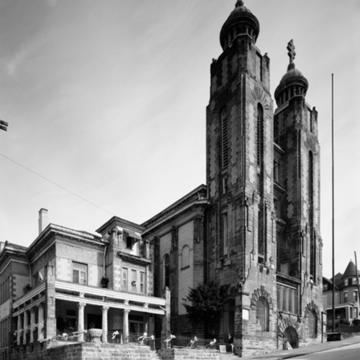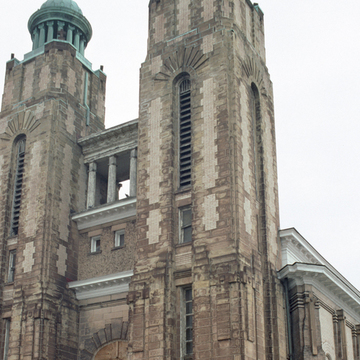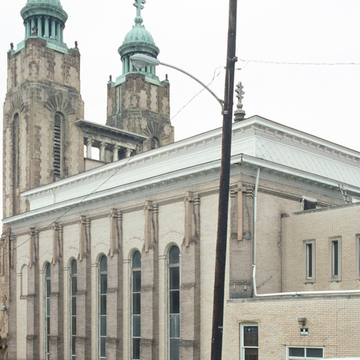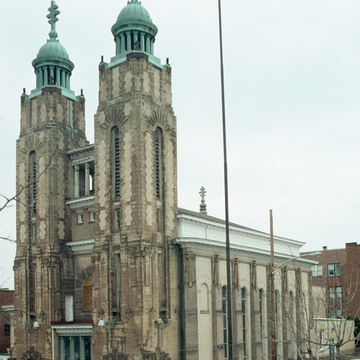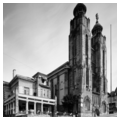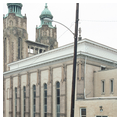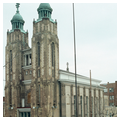You are here
National Carpatho-Rusyn Center (St. John the Baptist Greek Catholic Cathedral)
In their 1940s heyday, Homestead and neighboring Munhall were home to over fifty churches (about thirty survive), of which the former St. John the Baptist cathedral remains the most distinctive. It is that rarity in American architecture, a true Art Nouveau building, though of a peculiarly central European variety.
Located on the hill that characterizes much of Munhall, St. John's towers above the scores of worker houses in which its Carpatho-Rusyn parishioners lived. The facade of St. John's begins in walls of stone and brick on a raised stone basement, then soars into twin towers that have tall narrow windows under exaggerated sandstone voussoirs. The verticality of the towers is checked midway by the horizontal of a loggia in the center of the facade. The towers end in columned tholoi surmounted by Greek crosses. De Bobula created stunning textural discordances through jumps between smooth and rough-hewn stones. He overscaled the egg-and-dart molding and small modillion blocks under the eaves and cornices, to the point that a visitor eyes the whole church warily, as though it cannot be trusted. The architect's blend of historic styles is echoed in the adjacent two-story brick rectory, which incorporates fluted Corinthian columns and a cornice ornamented with acanthus leaves.
Little is known about Budapest-born Titus de Bobula (1878–1961). Long after he left Hungary, where his father and brother were well-known conservative architects, he maintained contact with the old country. In two of his surviving buildings, First Hungarian Reformed Church of 1903 at 221 Johnston Street in Hazelwood and Sts. Peter and Paul Ukrainian Orthodox Greek Catholic Church of 1906 at 200 Walnut Street in the suburb of Carnegie, as well as in a dozen sketches published in Pittsburgh, de Bobula quoted liberally from Art Nouveau and such Viennese pioneer architects as Otto Wagner. De Bobula is the most original force to have emerged from the many immigrant groups who enriched Pittsburgh with their artistic heritages.
Writing Credits
If SAH Archipedia has been useful to you, please consider supporting it.
SAH Archipedia tells the story of the United States through its buildings, landscapes, and cities. This freely available resource empowers the public with authoritative knowledge that deepens their understanding and appreciation of the built environment. But the Society of Architectural Historians, which created SAH Archipedia with University of Virginia Press, needs your support to maintain the high-caliber research, writing, photography, cartography, editing, design, and programming that make SAH Archipedia a trusted online resource available to all who value the history of place, heritage tourism, and learning.


